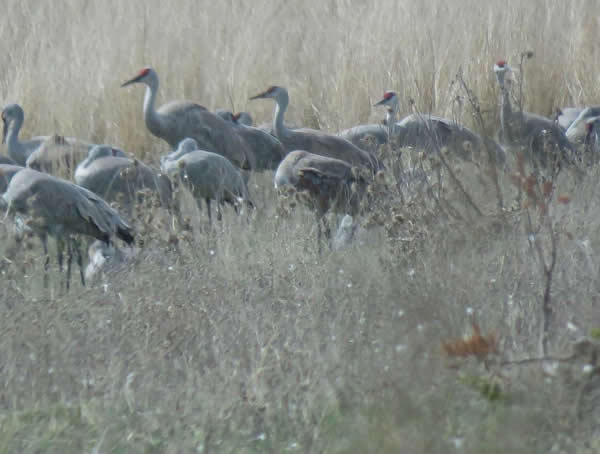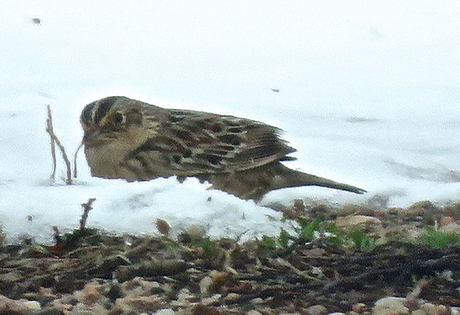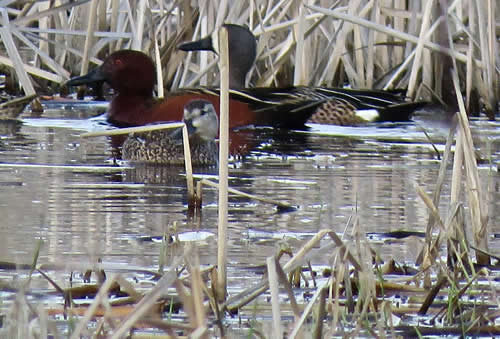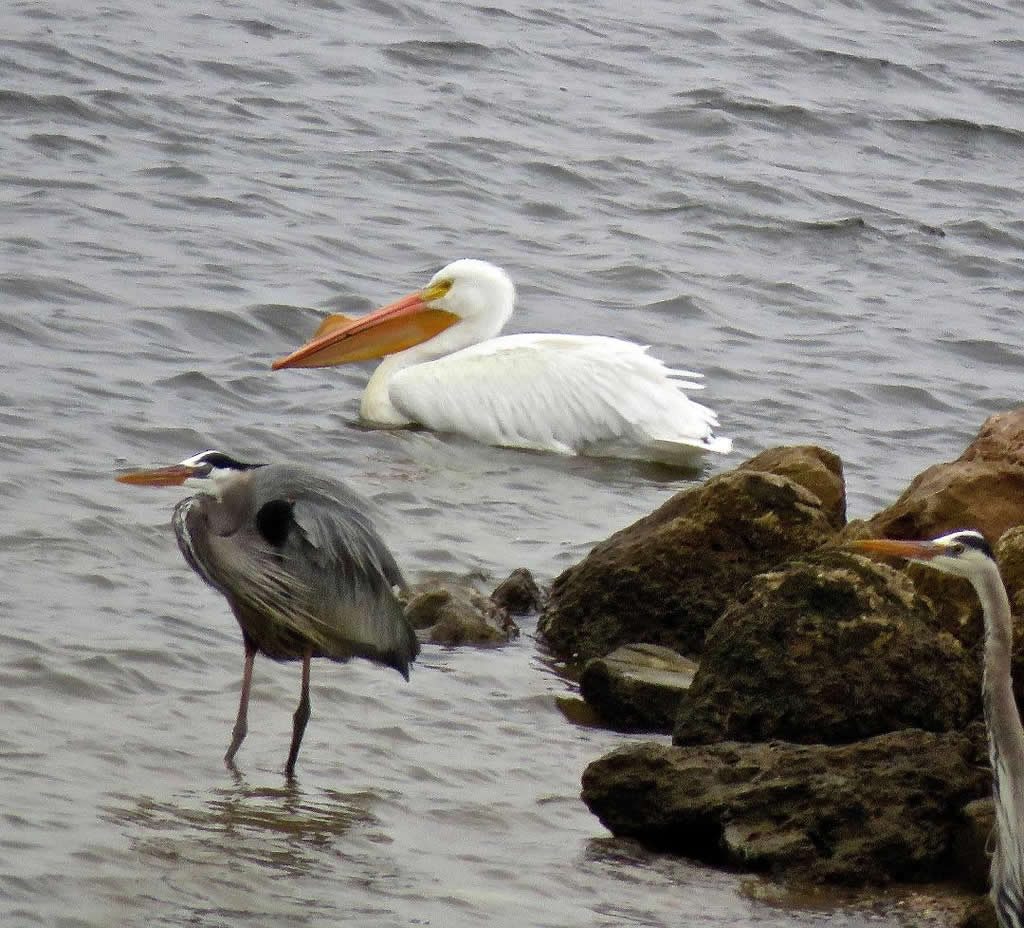Registrar: Anne Lazarus
Participants: 4
Weather: Monday: upper 40 to 70 degrees Fahrenheit, sunny, calm
Tuesday: upper 40’s to 50’s F, sunny and calm
Wednesday: upper 30’s to 40’s F, rain light to moderate, windy
Thursday: 20’s, Snow hazardous blizzard conditions am, clearing about 3:00 pm
Friday: 20’s to upper 30’s, mainly sunny, windy
Bird Species: 107
Monday, April 8
Our plane landed at 5:20 pm, and we were birding by 5:45 pm. Our first stop was Lake Manawa in Iowa where we saw Purple Martins busy inspecting Purple Martin nest boxes. We saw our only Common Loon at this site. We continued to Carter Lake, Nebraska/Iowa for late afternoon viewing of American White Pelicans, Lesser Scaup, Ruddy Ducks, Bonaparte Gulls, two Franklin’s Gulls, American Coots, a close Belted Kingfisher and many other water birds. Rick explained the difference between the Bronzed Common Grackle and the Common Grackle we see in the East.
Tuesday, April 9
Tuesday was a sunny, lovely day, but on our minds was Wesley, the approaching Blizzard. With those thoughts in mind we had an intense day of birding. We visited Tamora Cemetery where a pair of Eastern Bluebirds were residing. Continuing on to Oak Lake Park, the highlight here was an Eastern Meadowlark. By 7:50 we arrived at Lake Saline Wetlands. It was a treat to see Wood Ducks and several Blue-winged Teals, but the star was a male Cinnamon Teal courting a female Blue-winged Teal. Another interesting sighting was a Great-tailed Grackle, our only one of that species for the trip. Other water birds included: Mallards, Gadwalls, Buffleheads and American Coots. The habitat attracted two Swamp Sparrows, Fox Sparrow, Song Sparrows, Eurasian Collared Dove, another Eastern Meadowlark, Yellow-shafted Flicker, Downy Woodpecker and other land birds. We left this Wetland at 9:00 am and proceeded to the Tamora Waterfowl Production Area, arriving at 9:55 am to observe Western Meadowlark. New duck species included: Redheads, Ring-necked Ducks and Northern Shovelers. We always enjoy looking at Lesser Scaups. We did see our first shorebird, Greater Yellowlegs.

Arriving at the North Lake Basin Wildlife Management Area at 10:50 am, we did not leave until 12:03 pm. We were overwhelmed by six hundred Redhead ducks and two hundred Ring-necked Ducks. Here is a listing of all the duck species we saw: Redhead, Canvasback, American Wigeon, Mallard, Northern Pintail, Gadwall, Green-winged Teal, Blue-winged Teal, Lesser Scaup, Bufflehead and Ruddy Duck. We must not forget the American Coots and Pied-billed Grebes. Aquatic vegetation added to the richness of the wetland. Looking to the other side, we saw mud flat edges, where shorebirds were foraging. Both Greater and Lesser Yellowlegs, Killdeer, 2 Pectoral Sandpipers and two Baird’s Sandpipers were feeding on the mud flats. We finally had to force ourselves to leave.
We visited the Crane Trust Nature Visitor Center at 2:00 pm. and left at 2:35 pm. En route we watched approximately six thousand Sandhill Cranes flying and soaring. The bird feeders at the center attracted several Red-winged Blackbirds, Red-breasted Nuthatch, White-breasted Nuthatch, Downy Woodpecker, American Goldfinches, House Finches and Slate-colored Juncos. On the way to our next stop, the Rowe Audubon Sanctuary, we saw our first Loggerhead Shrike. It was hunting from a large wood pile with vertical stems. Also, a Ring-necked Pheasant was along the roadside. At last we saw a flock of Lesser Sandhill Cranes standing in the grasses. The Sandhill Cranes of the west are Lesser Sandhill Cranes. At the Rowe Audubon Nature Center we watched the feeders, which attracted the finches, Slate-colored Juncos, Downy Woodpecker and other birds. We arrived at 2:55 pm and left at 3:55 pm. From the road we saw a flock of mixed blackbirds, including Yellow-headed Blackbirds. At 6:10 we arrived at Cody Park, North Platt. The most exciting observation were a flock of Lesser Sandhill Cranes interacting in the grasses.
Wednesday, April 10

We awoke to rain and wind. The rain ranged from light to moderate. The day was chilly and raw. We knew that Wesley, the Blizzard was soon to strike and needed to make the most of this difficult day. Leaving the shopping mall at the hotel, a Say’s Phoebe flew up from the pavement and quickly disappeared. We began our journey to the Sandhills of Nebraska. Birding from the car, we saw two Northern Harriers. The Sandhills of Nebraska is an area of mixed prairie grass, providing ecological niches for several species, including birds. We saw manyWestern Meadowlarks, Vesper Sparrows, American Kestrels, Horned Larks and more. Suddenly a Greater Prairie-Chicken flew over the path. We followed it with our binoculars. Then a Long-billed Curlew flew across the grasses. As we exited into different terrain and farmland, we saw a Hermit Thrush and Merriam Wild Turkeys, a subspecies with a white terminal band on the tail. We had constant sightings of Vesper, Savannah and some Song Sparrows. Between the Sandhills and adjacent areas we saw 8 American Kestrels.
We arrived at Lake Ogalala at 10:30 am. One of our first sightings was three hundred Common Mergansers along with other water birds. Most exciting was a Glaucous Gull flying past us. We observed the lake from the car and saw the following: Bonaparte Gulls, Franklin’s Gulls, Ring-billed Gulls, Herring Gulls, Thayer’s Gull, and Lesser Black-backed Gull. We enjoyed close, detailed looks at American White Pelicans and 8 Great Blue Herons. We had fun watching the antics of Wood Ducks on the area opposite the lake along with more observations of Western Meadowlarks, Slate-colored Juncos, Killdeer and more.
From 2:30-3:20 we visited Sutherland Reservoir. To our surprise two Snow Geese were foraging in the vegetation. The ducks included Blue-winged Teals and Gadwalls, along with Horned Grebe. We had another opportunity to observe Vesper Sparrows with Savannah Sparrows; also briefly seen was a Ring-necked Pheasant along the edge of the road, and of course, the beautiful Western Meadowlarks among the other land birds. When we returned to the hotel, the weather was deteriorating, and by about 6:00 pm icy snow was falling.
Thursday, April 11

It stopped snowing at about 3:00 pm. and the birds were starting to feed once more. We went to a local park, Lake Maloney State Recreational Area. Another Ring-necked Pheasant made an appearance along the roadside. Gadwalls, Northern Shovelers, Lesser Scaup and Ruddy Ducks were huddled together for protection from the wind. Various species of sparrows were foraging in a small, sheltered corner of the park, and among them was a cooperative Grasshopper Sparrow. Other sightings were the Oregon subspecies of the Slate-colored Junco. Even more interesting was a Difficult Junco, intergrade between Oregon and Slate-colored Junco. Included in the flock of sparrows were: American Tree Sparrows, Song Sparrows and Vesper Sparrows. A Western Meadowlark was also present with other birds. Suddenly the sparrows were gone! A Loggerhead Shrike was sitting in the conifer tree. We noticed Lesser Sandhill Cranes flying and soaring once more.
We made a final stop at Centennial Park, North Platt, a very small park, but we saw a substantial flock of Cedar Waxwings. We did manage to bird despite the Wesley the Blizzard.
Friday, April 12
The blizzard was gone. It was sunny, cold and quite windy. We left North Platt at 5:00 am to go to the staging area where the Lesser Sandhill Cranes gather for their morning flight. When we arrived we could hear the cranes. As we walked along the path to the staging area our leader found a Le Conte’s Sparrow. We watched the sparrow until it receded into the brush. We waited in the frigid weather for the cranes to fly. Then suddenly we spotted another flock of cranes flying toward us, being pursued by a Bald Eagle. Then the cranes we were originally watching took off, and it looked as if the two flocks merged. The Bald Eagle was the impetus for the birds to take flight. As we returned to the van we saw several Vesper, American Tree Sparrow, Song Sparrow, Field Sparrows, but we could not relocate the Le Conte’s Sparrow for a second look.
We returned to the Crane Trust Nature Center, and here is what we saw: Field Sparrows, White-crowned Sparrow (gambelii sub species), Harris’s Sparrow, Grasshopper Sparrow, Song Sparrows, Slate-colored Juncos and more. We saw more Yellow-headed Blackbirds, Brewer’s Blackbird. and a Yellow-rumped Warbler, our only warbler for the trip. While traveling to our next destination we were lucky to see a close Swainson’s Hawk.
We then explored the cornfields and saw a distant flock of Lapland Longspurs. Afterwards we visited a small park where about 110 Chipping Sparrows were flying and feeding. In that area we birded a local pond and were treated to a sighting of 2 Eared Grebes.
We had to continue on our way to Omaha, Nebraska, but we made one more stop. It was time for some woodland birding. At the Fontenelle Forest in Bellvue, Nebraska, not far from Omaha, we did spot some migrating and resident woodland birds, but the main attraction were several resident, nesting Red-headed Woodpeckers.

Species Lists
Birds
Snow Goose
Canada Goose
Wood Duck
Blue-winged Teal
Cinnamon Teal
Northern Shoveler
Gadwall
American Wigeon
Mallard
Northern Pintail
Green-winged Teal
Canvasback
Redhead
Ring-necked Duck
Lesser Scaup
Bufflehead
Common Merganser
Red-breasted Merganser
Ruddy Duck
Ring-necked Pheasant
Greater Prairie-Chicken
Wild Turkey
Pied-billed Grebe
Horned Grebe
Eared Grebe
Rock Pigeon
Eurasian Collared-Dove
Mourning Dove
American Coot
Sandhill Crane
Killdeer
Long-billed Curlew
Baird’s Sandpiper
Pectoral Sandpiper
Greater Yellowlegs
Lesser Yellowlegs
Bonaparte’s Gull
Franklin’s Gull
Ring-billed Gull
Herring Gull
Iceland Gull (Thayer’s)
Lesser Black-backed Gull
Glaucous Gull
Common Loon
Double-crested Cormorant
American White Pelican
Great Blue Heron
Turkey Vulture
Osprey
Northern Harrier
Sharp-shinned Hawk
Bald Eagle
Swainson’s Hawk
Red-tailed Hawk
Rough-legged Hawk
Belted Kingfisher
Yellow-bellied Sapsucker
Red-headed Woodpecker
Red-bellied Woodpecker
Downy Woodpecker
Northern Flicker
American Kestrel
Say’s Phoebe
Loggerhead Shrike
Blue Jay
American Crow
Horned Lark
Purple Martin
Tree Swallow
Ruby-crowned Kinglet
Golden-crowned Kinglet
Red-breasted Nuthatch
White-breasted Nuthatch
Brown Creeper
European Starling
Eastern Bluebird
Hermit Thrush
American Robin
Cedar Waxwing
House Sparrow
House Finch
American Goldfinch
Lapland Longspur
Grasshopper Sparrow
Chipping Sparrow
Field Sparrow
American Tree Sparrow
Fox Sparrow
Dark-eyed Junco (Slate colored)
White-crowned Sparrow
Harris’s Sparrow
White-throated Sparrow
Vesper Sparrow
LeConte’s Sparrow
Savannah Sparrow
Song Sparrow
Swamp Sparrow
Yellow-headed Blackbird
Western Meadowlark
Eastern Meadowlark
Red-winged Blackbird
Brown-headed Cowbird
Brewer’s Blackbird
Common Grackle
Great-tailed Grackle
Yellow-rumped Warbler
Northern Cardinal
Mammals
Eastern Gray Squirrel
Eastern Fox Squirrel
Thirteen-lined Ground Squirrel
Eastern Cottontail
Muskrat
White-tailed Deer
Reptile
Garter Snake
Butterflies
Mourning Cloak
Red Admiral
Angle-wing Butterfly

